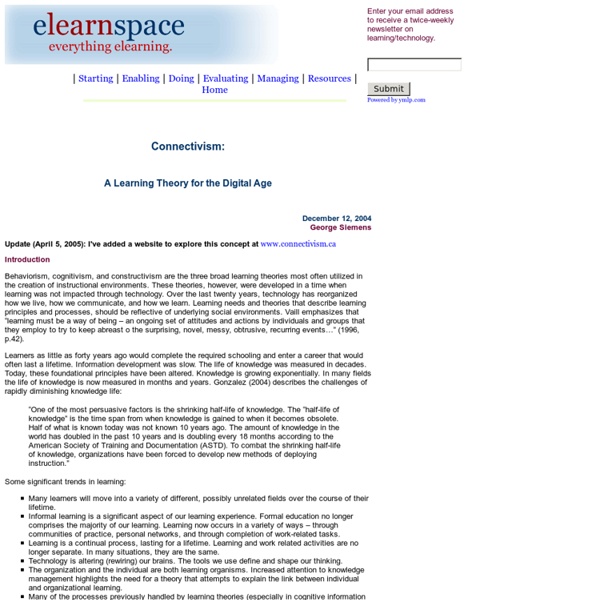Elearnspace. Connectivism: A Learning Theory for the Digital Age

http://www.elearnspace.org/Articles/connectivism.htm
Related: Week 2: Connected Learning, PLNs! (*=Key reading)
What Does Connectivism Mean for Education?
The theory of Connectivism provides new insight into what it means to facilitate learning in the 21st Century. Those responsible for teaching and training need to incorporate instructional strategies that match learner expectations and the physical changes that technology has wrought on the human brain. This is an ongoing challenge and one that does not have a single right answer or pre-packaged solution. The application of Connectivism to teaching and learning requires a thorough rethinking of the educational process and the role of the teacher, student, and technology in that process.
Graduate Program in Training and Development @ Roosevelt University
Connectivism: A new learning theory? Guest Blogger: Barry I came across the term Connectivism coined by George Siemens while doing research for TRDV 499 Master paper. The concept is interesting, giving thought to the digital era and how we learn. But is this a new learning theory? According to Siemens (2005), connectivism proposes:
In 2012, the biggest changes on the Web were in online education, social networks, and the increasing use of smartphones and tablets.
Live and learn: Everybody went mobile in 2012 (or so it seemed), but the most groundbreaking movement on the Web may have been the rise of digital education. For all the attention lavished on the Web’s growth on mobile devices this year, one of the most interesting Internet trends is still best experienced on a desktop computer: online education. The rising cost of higher education (the average bachelor’s degree now costs more than $100,000), combined with increasing access to high-speed Internet service and a desire for more efficient and flexible learning methods, brought new prominence to websites offering free or low-priced courses in everything from programming to literature.
The Wheel
The Motivation and Engagement Wheel, developed by Dr Andrew Martin, is a practical multi-factor approach to student motivation and engagement. It comprises 11 factors that are grouped under 4 themes (see figure to the right). The Wheel comprises:
Amy's EDC MSc blog
Often when trying to understand an online phenomenon, looking to the non-online version (if applicable) is a useful tool to start with for comparative purposes later of how the entity has changed in its online guise. “Online communities” – topic of exploration this week Task: Find an online community and study it. Instinctively, I felt I knew what a community was – a network of support, usually coupled with a sense of belonging, of like-minded or similarly experienced people e.g. a sports society or local mother and toddler group. However, despite using all three terms synonymously in my definition, I had absolutely no idea what made a group or a society or a community what it was and whether there was any distinction between them – a useful definition for choosing an ‘online community’ to analyse. So I went browsing on the internet to find out what ‘community’ meant…
Educational Hash Tags
#edude#eduFollowChallenge#edugreen #eduhashtag #eduit#edumindset#eduON (Ontario)#euduoz #edupd#edupreneur#edupunk #edutech #EduThingsILike#eduvc#eduvoxers #elemchat #elementary#elemsci #ell #ellchat#elrnchat #elt#eltchat#eltpics#emchat #emotionalliteracy#edpolitics #engagechat#engchat #engedu #EngineeringEducation#english #english-teacher#engsschat #enrichingkids#enviroed#e-safety#ESCchat#esdgc#esea#esl #esol#esp#ETAS#etcchat#ETcoaches#etmchat#ettipad #e20#expandedlearning
Connectivism: Its place in theory-informed research and innovation in technology-enabled learning
Special Issue - Connectivism: Design and Delivery of Social Networked Learning Frances Bell University of Salford, United Kingdom Abstract The sociotechnical context for learning and education is dynamic and makes great demands on those trying to seize the opportunities presented by emerging technologies. The goal of this paper is to explore certain theories for our plans and actions in technology-enabled learning.
Connectivism
Clarissa Davis, Earl Edmunds, Vivian Kelly-Bateman Department of Educational Psychology and Instructional Technology, University of Georgia Review of Connectivism Introduction
Related:
eLearning
•
LEARNING THEORIES
•
MOOC
•
bourdieu
•
Week 2 - Understanding Learners
•
Conectivismo


